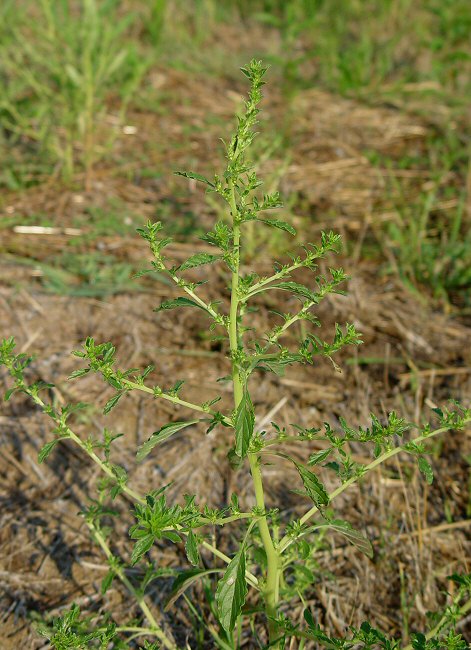Amaranthus albus Rodschied ex F. Dietr.
Tumbleweed

Native
CC = 0
CW = 3
MOC = 25
© DETenaglia
Amaranthus albus Rodschied ex F. Dietr.Tumbleweed | |
 |
Native CC = 0 CW = 3 MOC = 25 |
© DETenaglia |
|
Family - Amaranthaceae Habit - Annual monoecious forb. Stems - Ascending, to 1 m, branched and often forming dense, roughly globose masses, glabrous or pubescent, unarmed.
Leaves - Alternate, petiolate. Blades 0.5-4.0 cm long, elliptic to obovate, rounded or minutely notched at the tip, tapered at the base, glabrous.
Inflorescence - Mostly axillary, mostly small, dense, globose clusters, with a short, terminal spike occasionally also present, grayish green to green. Bracts 2.0-2.6 mm long, those of the pistillate flowers conspicuously longer than the sepals, lanceolate, sharply pointed, with a somewhat thickened midrib, the midrib extending beyond the main body as a short awn, somewhat spinelike at maturity.
Flowers - Staminate flowers with 3 similar sepals, these 1.2-2.3 mm long, erect or very slightly outwardcurved, lanceolate to narrowly oblong-elliptic, narrowed or tapered to a minute, awnlike extension of the midrib at the tip. Sepals of pistillate flowers 0.8-1.2 mm long, otherwise similar to sepals of staminate flowers. Petals absent. Stamens 3. Stigmas 3, more or less erect from a thickened base. Ovule 1.
Fruits - Mostly with papery walls, ovoid or ellipsoid, 0.9-1.5 mm, with 2 or 3 small beaks, with circumscissile dehiscence, 1-seeded. Seeds 0.7-1.0 mm, circular in outline, rounded along the rim, reddish brown to black, the surface smooth, shiny.
Flowering - July - October. Habitat - Waste ground, cultivated areas, disturbed sites, roadsides, railroads. Origin - Native to U.S., introduced into Europe, Asia, South America, and Africa. Other info. - This weedy species can be found in scattered locations in Missouri, most commonly in the western and southern halves of the state. The plant can be identified by its spreading, light yellow to whitish stems and axillary inflorescences. The minute flowers are subtended by aristate (spiny-tipped) bracts. The shiny black seeds, which are about 1mm in diameter, are typical of the genus. Once the plant completes its life cycle, the entire plant breaks off near the base and blows in the wind, dispersing seeds as it rolls along. This has given the plant its common name - "Tumbleweed." It is but one of several species which exhibit this behavior. A more common tumbleweed in the southwestern U.S. is Salsola tragus, another member of the Amaranthaceae. Photographs taken off Missouri Bottom Rd. near the St. Louis Airport, MO., 8-7-05. |